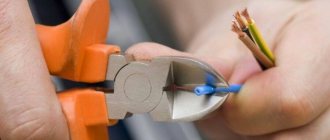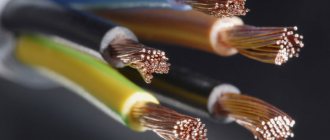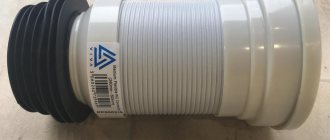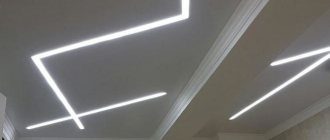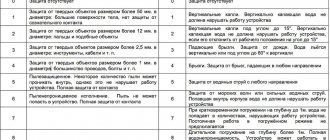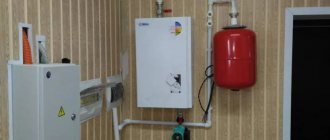Carrying out electrical work at home - be it laying or completely replacing electrical wiring in a house or connecting just one lamp in a new place - is inevitably accompanied by the need to remove the electrical insulating sheath from the ends of the conductors. Let's look at how wire stripping should be done correctly and what will happen if you do it without a special tool, what types of special tools there are, what are the features of the elementary and professional approach, as well as what criteria you need to pay attention to when choosing a particular method and tool in specific conditions .
A special tool allows you to clean the wire from the sheath without damaging it Source 5watt.ua
Stripping wiring - features of using special tools
How correctly the connection of electrical wiring elements is made will determine not only the quality of the power supply, but also the safety of the home. Therefore, when carrying out electrical installation work, it is extremely important to use special devices for stripping insulation from wires.
Removing the insulating shell without the use of special tools can result in the following series of undesirable consequences:
- Damage to the electrically conductive metal core or hairs, which will inevitably result in a reduction in cross-sectional area. Subsequently, this can lead to breakage and breakage of the circuit, and in the worst case, heating and fire.
- The formation of hidden defects, which will subsequently lead to the core breaking when bent.
- Reduction in conductor strength due to defects in the structure.
- Breakage of side hairs in a multicore cable.
- Clogging of the conductor surface with insulation material residues.
Removing insulation from a conductor with a knife is fraught with the formation of core defects. Source skilljob.ru
In addition, removing the electrical insulating sheath using special tools allows you to avoid injuries to the installer himself, as well as improve the quality and productivity of work. This is especially true when a large number of connections are being made, for example, when installing wiring in a new home.
Why do you need to remove insulation?
The insulating layer is usually removed from wires for the purpose of replacing or updating the connection. There can be quite a lot of cases for this. It is especially common to expose the ends of wires when replacing switches and sockets. Connecting some electrical devices also requires a direct connection to the network backbone. And this leads to the need to strip the wires.
Wires without insulation
Sometimes you have to replace the old protective layer. Then the old base is removed and replaced with a new one. Oxidation of the wire may remove the damaged area, which requires reconnection. Need to increase cable length. In each of the presented cases, the presence of bare ends is required, which will later be connected to the same parts of another conductor.
You may be interested in Description of the DT9205A multimeter
Types of instruments
Modern tools used for stripping wires and cables are classified according to several criteria:
- Method of removing the shell.
Two methods are used - thermal and mechanical. The first is typical for conductors with a small cross-section and a small amount of work, the second - for professional maintenance and a large number of operations.
Depending on the method of influencing the shell material, mechanical methods are divided into two types:
- Cutting. The cutting edge of the tool carefully cuts the sheath around the metal core, after which a smaller part of it is simply removed from the edge of the conductor.
- Break. Using special teeth, the conductor is clamped in the working part of the tool, and then the sheath is forcefully torn off along the conductor.
The choice of method and type of tool is primarily determined by the cross-sectional area of the conductor, complexity and volume of work.
- Operation speed.
According to the parameter of the number of shell removal operations performed in a certain period of time, tools are divided into 2 categories:
- Household. These include electrical knives, side cutters, and pliers. The devices are designed for stripping wires with a small amount of work.
- Professional. These are primarily strippers, tongs, pliers and pullers. They make it possible to quickly strip the conductor sheath.
A knife is most often used in everyday life due to its availability, ease of use and low cost.
- Degree of automation.
According to the degree of automation, devices are divided into manual, semi-automatic and automatic. This classification is typical primarily for professional instruments.
An automatic stripper significantly increases the productivity of conductor stripping Source remitek.ru
On a note! Cleaning tools can be either universal or special purpose - for example, only for an Internet cable or power wire. They may also differ in the diameter of the conductor. The most popular models are for cores with a diameter of 4 to 40 mm.
See also: Catalog of companies that specialize in engineering systems (heating, water supply, sewerage and others) and related work
Tool for quickly stripping old wires
Sometimes it happens that a large number of old and unnecessary wire scraps accumulate in the workshop.
Of course, some of them can still serve in some projects, and some that have breaks inside are easier to dissolve and hand over to a non-ferrous metal collection point.
In this review, we will tell and show how to make a small machine for quickly stripping insulation from unnecessary wire scraps.
For manufacturing you will need the following materials: a round knife from a pipe cutter or tile cutter, a pair of bevel gears, a pair of sockets with bearings, a small piece of reinforcement, a few studs and some nuts with washers.
In addition, you will need a couple more sheet metal plates and some old handle. The tools you will need are: a welding machine, an angle grinder, a drill, a marking tool and several open-end wrenches.
Main stages of work
First, we cut out the required metal plate for the lower part of our machine. Mark and drill four holes in the corners. We insert the pre-prepared studs into the holes and secure them with nuts.
We cut off a small section from the reinforcement to make the shaft. We adjust it to the required size and fix the gears opposite each other with the tops of the cones.
We put sockets with bearings on both sides and install them on the studs. We fix everything through the washer using nuts.
Now you can make the cutting part. To do this, cut a longitudinal hole in the hairpin and try on the knife. If everything fits, then remove the threads on both sides of the stud and drill a hole. We fix it to a bolted connection.
The top cover is cut the same size as the bottom and with the same holes. Another hole is drilled in the center, we install a knife in it, and secure it with nuts.
Install the top cover and tighten everything with nuts. We weld a piece of metal strip to the output shaft from the gears and secure the handle for rotation. The knife is adjusted using two nuts.
Our homemade product is ready and we can get to work. To learn in detail how this tool is made, you can watch the video below. The review is based on a video from the YouTube channel DIYFixMan.
How to Build a Homemade Tool for Copper Wire Stripping - DIY
Elementary cleaning methods
There are two main ways to quickly clean wires or cables of insulation - by heat treatment or firing and without heating, that is, mechanically. Each of them has the following characteristics and scope of application:
- Thermal.
The method involves heating the edge of the conductor to a temperature when the material of its electrical insulating shell begins to melt or burn. If the area that needs to be stripped of insulation is large enough, not the entire section melts, but only the area to which stripping needs to be done. Then the remainder is removed from the edge with pliers.
For heating, 3 devices are used:
- Soldering iron.
- A lighter or other open flame source.
- Hot nichrome thread.
The method is good for a small amount of work and is used to remove insulation from thin wires designed to transmit voltages of no more than 5 volts. Since such wires are easily damaged by a knife or other tool.
- Mechanical.
The method involves cutting the insulating shell with the cutting edge of a sharp hand tool - for example, a knife. A special electrical installation model or a homemade one made from a hand-saw blade can be used.
The cutting technique should be performed in such a way that the surface layer of the metal core or hairs is touched as little as possible. To do this, the tip of the cutting part is directed at the most acute angle possible with respect to the shell. The method is suitable for small or medium volumes of work, provided the craftsman has sufficient experience, and when the shell is made of PVC or rubber.
The electrical installation knife has a special handle made of dielectric - for working with live wires Source inbenzo.ru
How to choose a stripping tool
To carry out the procedure quickly and efficiently, you first need to divide the cable into cores. This procedure must be done extremely carefully so as not to damage the structure of the vein base. It is not recommended to rush when cutting the insulation - you can make the cut too deep. At the end of this stage of work, you need to pick up part of the insulating layer and carefully remove it from the core. Careful handling of the wire will prevent it from being torn or damaged. When removing insulation, it is very important not to cut the remaining wires.
The second situation when it is necessary to remove the protective layer from the cable is loaded sections of electrical networks.
The most striking examples are:
- internal filler insulation layer;
- rigid and dense external insulation;
- fabric insulation, which is impregnated with a resin composition;
- individual insulation of all cores.
To remove the protection, you need to remove the outer shell using a tool. For this purpose, a shallow cut is made along the cable. Using pliers will allow you to remove the wires. This must be done one piece at a time, otherwise you will have to remove the inner fabric or fill. The remaining part of the outer insulating layer simply needs to be cut off.
Isolation after cleaning
Taking into account all the structural features of a cable or wire, you can choose the right tool for working with the electrical components of the circuit. Otherwise, the choice may be made unconsciously, taking into account the recommendations of the sales consultant.
Using a professional tool
For a large volume of electrical installation work, there are 4 main types of special tools that allow you to quickly and without damaging the wires strip the insulation from the wires:
- Nippers and pliers.
These are quite versatile and easy-to-use devices for cutting sheaths on both wires and cables. To strip, select the desired diameter along the conductor, then grab it and twist it around. After this, the sheath is simply pulled off the end of the wire.
Advantages of the device:
- Reliability.
- Possibility of cleaning in hard-to-reach conditions.
- Long service life.
- Working with live wires.
The disadvantages are associated with the impossibility of adjusting the tool to the length of the layer being removed and the need to reconfigure it for different diameters.
- Wiring knife.
Traditional device for quickly removing the casing. Mainly used for working with flat cables. The insulation is cut away from you with a knife. In this case, the cutting part of the tool should be directed at an acute angle to the material.
The knife for stripping cables has a specially shaped blade. Source remoo.ru
Advantages:
- Versatility - fits any wire.
- Affordable price.
- Availability of specimens with a handle covered with electrical insulation, which makes it possible to work with live wires.
Disadvantages are associated with the duration of the processing process, labor intensity for large-diameter conductors and the need for experience, without which metal conductors can be damaged.
- Stripper.
A professional tool specially designed for stripping wires of insulation. The operating mechanism is based on passing the conductor through a pair of movable semicircular working elements. The accuracy of the cut is determined by setting the device to the cross-section of the core.
Depending on the conditions and scope of work, 3 types of stripper are used:
- Manual.
- Semi-automatic.
- Auto.
Some models, in addition to the main task, allow you to crimp, trim and twist conductors.
A professional stripper is best designed for quickly removing insulation from wires Source ytimg.com
Electrician's knife - a traditional tool
A knife with a curved blade simplifies the work and speeds up the stripping process. There are several types of such devices.
Features of using the device
An electrician's knife is more suitable for stripping flat cables. Experienced craftsmen will easily remove the insulation from round wires, but the ease of use will be less.
Removing the protective shell using a knife must be done with gloves to avoid injury. This is especially true when stripping cables manufactured in accordance with GOST. The insulation thickness of such a conductor is much greater than that of a wire according to specifications, and it fits more tightly to the cores, which complicates the work.
When performing stripping, the tool must be held at an acute angle relative to the cable. If this rule is neglected, there is a high risk of damage to the soft metal conductor.
The braid is removed with light movements, cutting the insulation away from you.
The main advantages of using knives:
- affordable price;
- availability of models with an insulated handle;
- practicality - the knife is suitable for wires of different diameters.
The main disadvantage is the duration of work. Stripping large cross-section cables is quite labor-intensive. In addition, with little experience there is a risk of damage to the cores.
Variety of electrician knives
There are three options for electrician knives. They differ from each other in the shape of the blade and the type of tip.
Knife with heel. A device with a short wedge concave inward. A “heel” is soldered perpendicular to the blade, limiting the depth of the cut.
This knife is perfect for preparing double-insulated wires, when the top protective layer needs to be removed, but the bottom one needs to be left intact.
It is better to use a plow tool for wires with hard conductors; a knife removes the soft encircling sheath worse.
Knife with beak. A tool with a rounded blade. This knife has a very smooth bend, unlike the “heel”. The specific shape of the wedge complicates the work; the device is more often used by experienced craftsmen.
The beak-shaped point is suitable for making a circular cut in the shell. Longitudinal cuts must be made with extreme caution, since there is no cut depth limiter
Knife with hook. This tool is capable of transverse cutting and longitudinal cutting of cables. The wire is fixed at the top with a bracket, and a sharp fang cuts through the insulation.
You can set the cutting depth of the protective sheath on the knife - an adjustment wheel is provided for this.
This model is universal and suitable for processing most types of cables. The device is popular among professional electricians.
Evaluation of instrument quality parameters
When choosing a knife for stripping the insulating layer, you must follow a number of rules.
Primary requirements:
- It is better to use a knife with a small blade. The tool will be convenient to use in a limited space (cabinet, panel).
- The blade should be made of durable steel - such metal retains its sharpness longer.
- It is better to choose a straight edge - this will simplify the cutting of double-insulated wires.
You need to pay attention to the sharpening of the blade. It should not be too sharp, otherwise it is easy to get hurt when working.
In addition, a sharpened tip can accidentally damage the cores of the cable being processed or adjacent wires.
Some tools have an insulated handle. The maximum voltage that the knife can withstand is indicated on the device itself.
Criteria for choosing a tool and method
When choosing a device or method for stripping a cable, it is important to take into account not only the amount of work to be done, the experience of the technician and financial capabilities, but also the following features of the conductor sheath materials:
- Coaxial wire. The upper shell is removed thermally, the lower – with a stripper. Other methods may damage the load-sensitive conductors.
- Cable with fluoroplastic insulation. The shell is highly heat resistant. Therefore, mechanical methods are better suited for stripping - with a knife or stripper.
- Wire with enamel protection. When the core cross-section is small - no more than 0.2 mm² - the thermal method is used.
Advice! When choosing a tool for removing the sheath from a conductor, it is important to consider the range of working diameters and the type of handle material. If work with live electrical wiring is expected, the handle must be made of dielectric.
Safety precautions when stripping wires
It should be understood that this process can be highly dangerous, so it is simply necessary to follow some safety precautions.
Let's look at the most basic ones:
- Do not leave bare sections of wire, they should be cut as they pose a risk of electric shock.
- This process requires accuracy and attentiveness; sudden movements should not be made.
- Do not leave any damage on the conductor and wire sections.
- High-quality methods for connecting wires should be used.
- Only high-quality tools should be used to avoid damaging the wire.
Damage to the wire can lead to a lot of unpleasant consequences, such as a short circuit or malfunction.
Briefly about the main thing
The use of special tools for cleaning conductors from the sheath allows not only to increase the speed and quality of work, but also to avoid a number of negative consequences:
- Core damage.
- Hidden defects.
- Reduced wiring strength.
- Breakage of individual veins.
- The conductor is clogged with insulation material.
Modern peeling tools are classified according to three criteria - removal method, speed and degree of automation. Elementary methods at home allow you to remove insulation by heating or using a knife. For large volumes of work, special devices are used - wire cutters and pliers, electrical knives, strippers, side cutters and pliers. When choosing a method and tool, among other parameters, it is necessary to take into account the type of shell material.

